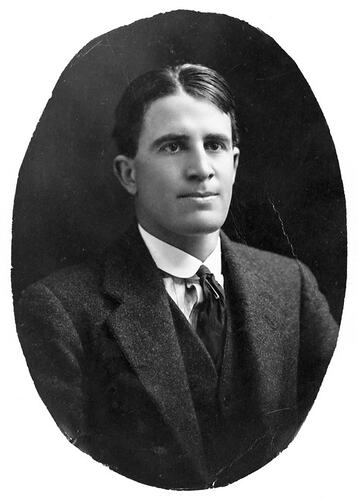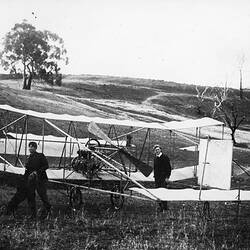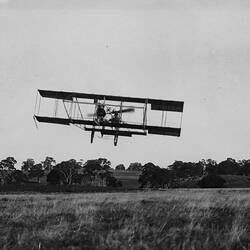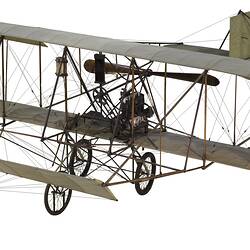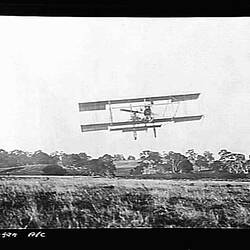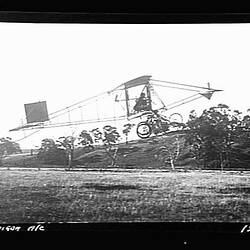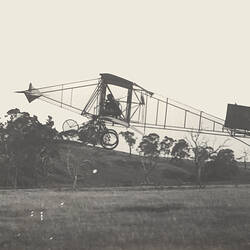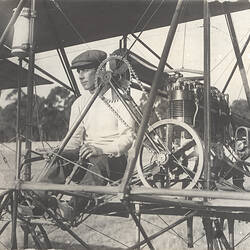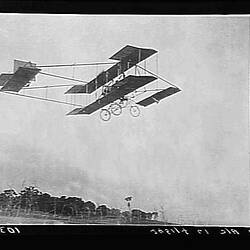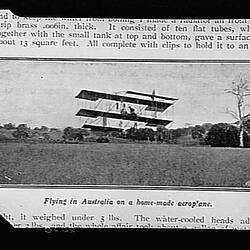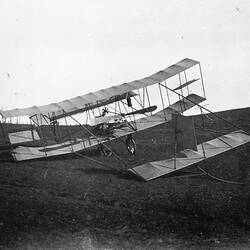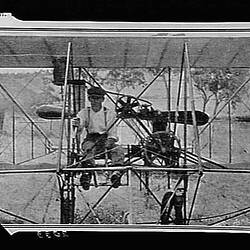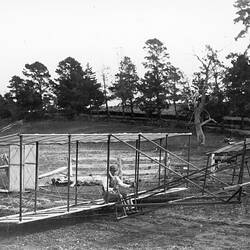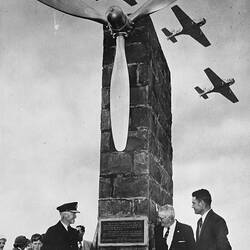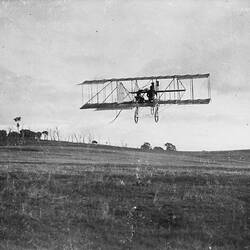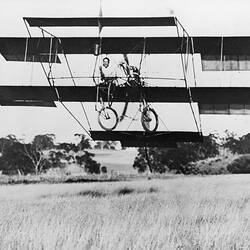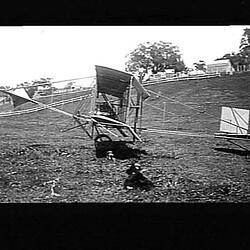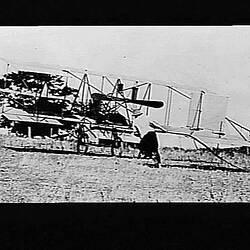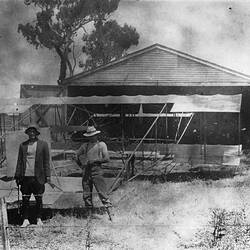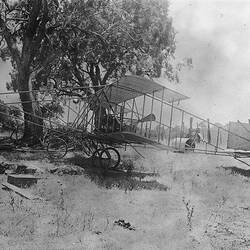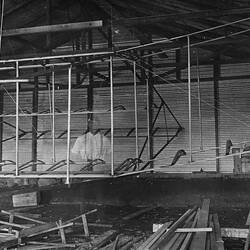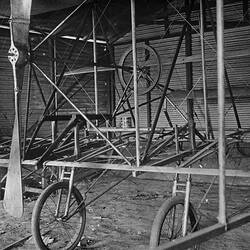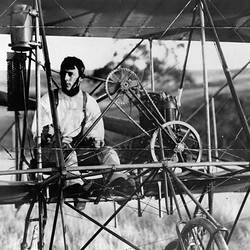Born in Melbourne on 15 September 1888, Reginald Charles Duigan was the youngest child of John Charles and Jane Duigan. His older brother was John Robertson Duigan (1882-1951).
During his childhood, the family lived in Brighton and Elsternwick and Reginald began attending classes at Brighton Grammar School in 1900 where he excelled at sporting and academic pursuits winning prizes in both fields. He also spent a year at school in Switzerland, while his parents were travelling in Europe and became fluent in French, retaining the language well into old age. Despite a strong mechanical aptitude and inventive mind, Reginald did not pursue formal technical education unlike his brother John who travelled to England to study electrical engineering and motor mechanics. Instead Reginald elected to assist his father in running the family's pastoral properties.
By 1908 Reginald was managing 'Spring Plains', a 10,000-acre sheep station at Mia Mia in central Victoria owned by his father. After his brother returned from England, he joined Reginald at Spring Plains and shortly afterwards began building a Wright-type glider and later a powered Farman-type biplane after hearing of Wilbur Wright's 1908 flights in France. Reginald also developed a keen interest in aviation and built model gliders which flew well. He later demonstrated his models in a public competition at the Melbourne Cricket Ground.
Reginald assisted John in constructing the biplane which was assembled in a specially-built shed on the top of a rise near the homestead. Although an engine, propeller and parts for the undercarriage where obtained from engineering firms in Melbourne, all other components required were made on the farm. Reginald was entrusted with a great deal of the repetition work, fabricating numerous metal fittings and aerofoil ribs from red pine for the wings. He was always on hand to assist John with every test flight made in the plane and to record events with his camera. Both brothers enjoyed riding and tinkering with motorcycles and driving their father's Leader car and motor buggies at Spring Plains. Reg invented an ingenious self-opening counter-balanced front gate for the property that could be activated by a driver without getting out of the motor car. He competed in local sporting activities and was an enthusiastic banjo player for social events at the local hall.
On 16 July 1910 the Duigan biplane achieved a short flight from the creek flat at Spring Plains with John at the controls, the first by an Australia-built aeroplane. With assistance from Reg, John continued to improve and modify the machine until he managed to fly for 196 yards (180 metres) on 7 October 1910 - an event that John regarded as the first true controlled flight. Reg later described the biplane as John's "pidgeon and he gave it everything". Reg also successfully completed about 12 flights in the biplane himself, before it was retired to the shed in mid-1911 never to fly again. It was donated to the Melbourne Museum by John in 1920.
John returned to Britain in late 1911 to obtain his aviator's certificate and Reg followed him there in 1912 with the same intention, but by the time he arrived John had sold the Avro biplane he had purchased from A.V. Roe. Reg flew a seaplane from Lake Windemere as consolation. The brothers decided to purchase parts from A.V.Roe and kept the ENV engine from John's British-built machine to build a new biplane in Melbourne. Work began at their parent's house in Marshall Street, Ivanhoe, soon after their return in late 1912 and was finished by early February 1913. The biplane crashed during its first test flights at Keilor on 17 February 1913 injuring John.
Reg returned to live at Spring Plains and in May 1914 married Phyllis Mary Peck, the granddaughter of John Murray Peck who, together with Freeman Cobb, John Lamber and James Swanton as four young American immigrants, had founded famous Cobb & Co coaching firm in Victoria in 1854. The couple had four children, Brian, Terence, Suzanne, and John, who would all later pursue interests in aviation.
Reg continued to invent and patented the 'Lock-Grip' wire strainer in 1916, which was put into production in England. After the sale of Spring Plains in 1921, the family moved to 'Cooraminta', a property at Elliminyt near Colac, where Reg patented a plug petrol pourer, a device for opening split rim wheels in 1926 and a new type of box spanner in 1931. He played tennis at senior level in the Country Tennis Championship at Kooyong in 1930. In 1936 Reg travelled to Japan as a result of a long-standing interest in that country. After moving to Geelong in 1944, Reg continued to experiment at his home in Newtown. Following John's death in 1951, Reg was increasingly involved in historical activities relating to the 1910-11 flights and wrote to the Museum providing information after the 50th anniversary celebrations in 1960 during which a monument was constructed at Mia Mia near the entrance to Spring Plains. Reg Duigan died at Geelong on 15 June 1966.
References:
Crotty, David, A flying life: John Duigan and the first Australian aeroplane, Museum Victoria, Melbourne, 2010.
Kendall, F.J., 'John Robertsoon Duigan, a pioneer aviator in Australia', The Victorian Historical Magazine, No.45, 1974.
Meggs, K., Australian-Built Aircraft & the Industry, vol.1, book 1, 1884-1939, Four Finger Publishing, Seymour, Victoria, 2009.
Parnell, N. & Bouighton, T., Flypast: A Record of Australian Aviation, Australian Government Publishing Service, Canberra, 1988.
Duigan, John Robertson (1882 - 1951), Australian Dictionary of Biography Online Edition, http://adbonline.anu.edu.au/biogs/A080384b.htm.
John Robertson Duigan & Reginald Charles Duigan, http://www.ctie.monash.edu.au/hargrave/duigan_bio.html.
More Information
-
Keywords
-
Localities
Mia Mia, Victoria, Australia, Colac, Victoria, Geelong, Victoria
-
Authors
-
Article types
